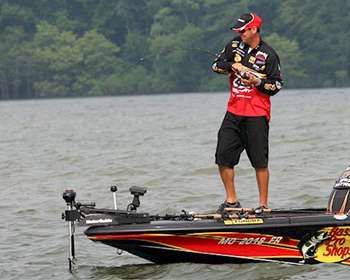
Lipless crankbaits are thought of as a power fishing lure that is cast a long distance and quickly retrieved at a steady pace.
They've even been referred to as "dummy baits" for the straightforward cast-and-crank technique that is most often used. While burning lipless crankbaits in open water can be deadly, Kevin VanDam believes that many anglers overlook the subtleties of fishing this compact lure.
With three Bassmaster Classic titles to his name, VanDam is known for his aggressive style of fishing, making thousands of casts and covering vast amounts of water in an average tournament day.
When it comes to fishing lipless crankbaits like the Strike King Red Eye Shad, he says that it's actually important to slow down. "With a lipless crankbait, a lot of people over-reel the bait," he says. "They fish it on a high-speed reel and they fish the bait too fast. What makes these baits really effective and special is that you are able to keep them down on the bottom and in the strike zone." In order to slow his retrieve, VanDam uses a 5.3:1 Quantum Tour KVD reel which features a wide spool.
"The wider spool brings in a lot of line and it's a little bit slower so that I can make sure the bait is keeping good bottom contact," he says.
VanDam pairs the reel with a 7-foot, medium action Quantum Tour KVD cranking rod. When retrieving a lipless crankbait, VanDam constantly stresses the importance of making contact with the bottom. "The trick with this bait is that it needs to hit the bottom every time," he says.
After making a long cast, VanDam lets the bait hit the bottom and then moves the bait by making long sweeps with his rod. "When the bait is falling, that's when I'm going to get bit." VanDam says the design of the Strike King Red Eye shad is another important factor when bottom bouncing the bait. "It's balanced so that when it falls, it has a perfect wiggle and won't flip over and tangle the hooks. It stays perfectly balanced and it's built to yo-yo," he explains.
While the technique is deadly on bare gravel bottoms when bass are chasing baitfish, he also utilizes the technique in shallow water where cover like wood and grass are prevalent. The important thing, he says, is to make sure that the bait is hitting and deflecting off of the cover. "When you hit a stump or clump of grass, rip it free and let the bait flutter," explains VanDam. It was this "bump and flutter" technique that he used to win the 2010 Bassmaster Classic on Alabama's Lay Lake.
"If you're fishing these baits right, you won't lose many fish and you won't miss many," says VanDam. "This has been one of the baits that I've won a lot of money with, but there's a lot more to it than just casting it out and reeling it in."
(Provided by Z3 Media)




